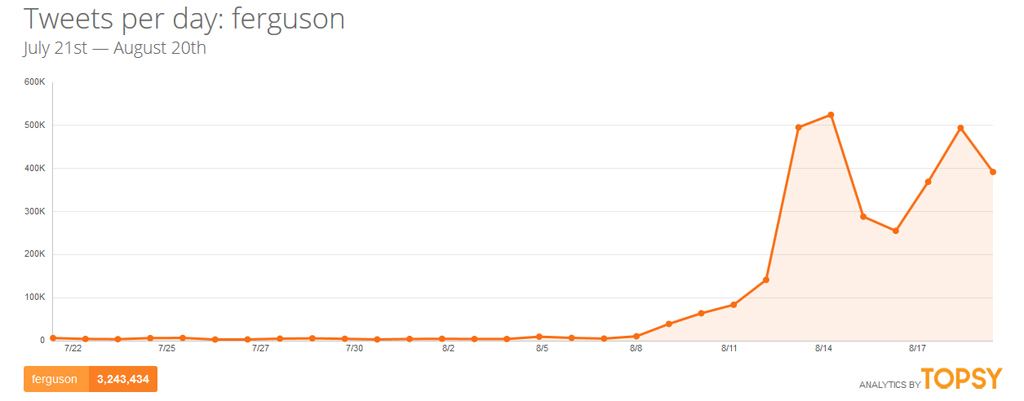Ferguson and the post-TV protest: ‘The media abandoned us’
We have had social media revolutions. Now it’s the turn of the so-called “post-TV” protest, with clashes in Ferguson being live-streamed by demonstrators – and racking up millions of views.
In the 11 days since unarmed black teenager Michael Brown was shot dead by police, protests have been staged in Ferguson, Missouri every night.
Many have been characterised by aggressive arrests and according to police, pockets of violence from protesters. Overnight on Tuesday 19 August, another black man was shot dead after wielding a knife and reportedly threatening police officers. Since Sunday, 78 people have been arrested, according to local media, the vast majority for refusing to disperse.
With racial tension between the predominantly black community and majority white police force running high, it is no surprise that protesters are armed with smartphones, tweeting pictures and trying to hold authorities to account.
Antonio French, a local politician who has been one of the main documenters of the protest movement on social media, told Channel 4 News: “Social media is directly responsible for why you see so many people out here, why you see people talking about Michael Brown in different cities across America and across the world. It gets it out instantly.”

This graph from Topsy (above), the Twitter analytics company, shows how the number of tweets worldwide mentioning “Ferguson” rose to over 500,000 at its peak on 14 August: in the last month, there have been 3,243,434 tweets mentioning “Ferguson”.
One of those mentioning the protests on Twitter was co-founder and St Louis native Jack Dorsey, who was on the streets this week. He was shy when we asked him to speak on camera – but has been vocal about his position on the social media platform.
“We young, we strong, we marching all night long” #Ferguson
— Jack (@jack) August 20, 2014
But it is the advances in livestreaming that have really allowed people across the world to witness what is happening, thanks to people like Mustafa Hussein, a student and volunteer at KARG Argus Radio, whose livestream from the streets of Ferguson in the early hours of 14 August has racked up over 1.3m views since it was first broadcast (see below).
He has filmed some of the most contentious clashes between police and protesters and streamed them on the live channel “I am Mike Brown Live from Ferguson, MO“, and his footage was used by mainstream TV stations in the US.
“There is a longstanding history in this county of the officers themselves being uneducated on what the constitutional rights of civilians are,” he told The Huffington Post.
Search “Ferguson” on the livestreaming site and phone app ustream.tv and dozens of videos appear for every day of protest, including speeches by community leaders, street-level footage of demonstrations and confrontations with police. This has all led the protests to be deemed one of the first “post-television” news stories by various websites.
Mainstream media
Amid curfews and police orders to disperse, multi-person TV crews with cameras have at times struggled to get footage. Many journalists have been held by police themselves and suffered the effects of tear gas, with police arguing they can’t identify them, and are under strict orders to disperse crowds at all costs. Channel 4 News’s own Kylie Morris had a police officer point a gun in her face.
But she also witnessed a protester, angry with the media, smash up one of her colleague’s TV cameras. Part of what is feeding the constant stream of video, tweets and live documenting seems to be a distrust in mainstream media.
Twitter user Alan Dicken quoted a local pastor saying “the media has abandoned us”, while on Instagram, mypthegreat posted a video with the following caption: “Look at all of the violence… oh wait there isn’t any. This is a video of organisers giving out free toiletries and personal products to those in need.”
A local rapper who goes by the name of Haiku has been posting regular video updates on his Instagram account, which now has nearly 9,000 followers. He said he was driven to keep tabs on what was happening to try and prove that the violent protesters were in the minority.
“The way that the media was portraying the riots they made it seem like the protesters, the people that came out here trying to get justice for Mike Brown were the ones behind QuickTrip (a local shop) being burned down, and all the other stores being looted,” he told a US media outlet. “So, my documentation from that point was to show that that wasn’t us.” It was also about the police, he added: “Once we started getting in the encounters with the police where we were getting tear-gassed and things like that, it needed to be documented.”
When Channel 4 News spoke to Haiku on Tuesday, he said that at first, journalists were only seeing the aftermath of what had happened. “Social media helped bring global attention to the situation and also helped people outside of Ferguson see what is really happening and the different roles people play,” he said, adding: “I am seeing an increase of live streaming and people pulling out their phones to capture these events.”
The protests in Ferguson show no sign of easing – and the smartphone continues to be the essential accessory of choice.
As one Twitter user summed up in the language of the modern, 140-character news bulletin: “Aiight imma stop tweeting cuz my phone about to die and don wanna be caught in this riot s**t with a dead battery #Ferguson #MikeBrown.”